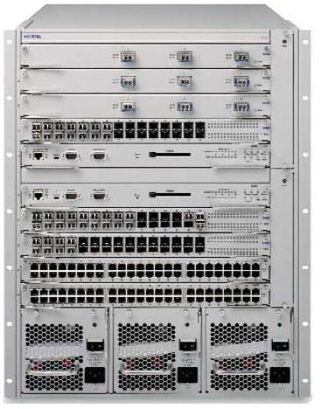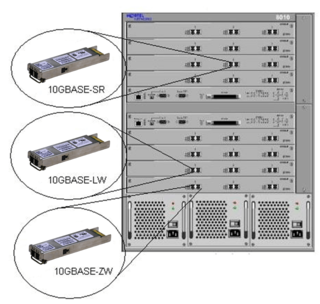
Small Form-factor Pluggable (SFP) is a compact, hot-pluggable network interface module format used for both telecommunication and data communications applications. An SFP interface on networking hardware is a modular slot for a media-specific transceiver, such as for a fiber-optic cable or a copper cable. The advantage of using SFPs compared to fixed interfaces is that individual ports can be equipped with different types of transceivers as required, with the majority including optical line terminals, network cards, switches and routers.

Carrier Routing System (CRS) is a modular and distributed core router developed by Cisco Systems Inc that enables service providers to deliver data, voice, and video services over a scalable IP Next-Generation Network (NGN) infrastructure. In a network topology, these routers are generally positioned in the core or edge of a service provider network. They are also used by Over-the-top content providers and large enterprises. It supports a wide range of interface speeds and types such as channelized OC3, OC12 to OC768 on Packet over SONET and from 1GE, 10GE all the way to 100GE on the Ethernet technologies. A standalone CRS-3 system can handle 2.2 Tbit/s and a multi-chassis system could be designed to handle 322 Tbit/s.
MRV Communications was a telecommunications company based in Chatsworth, California. MRV Communications was acquired by ADVA Optical Networking on August 14, 2017 for a reported $69 million.

A passive optical network (PON) is a fiber-optic telecommunications network that uses only unpowered devices to carry signals, as opposed to electronic equipment. In practice, PONs are typically used for the last mile between Internet service providers (ISP) and their customers. In this use, a PON has a point-to-multipoint topology in which an ISP uses a single device to serve many end-user sites using a system such as 10G-PON or GPON. In this one-to-many topology, a single fiber serving many sites branches into multiple fibers through a passive splitter, and those fibers can each serve multiple sites through further splitters. The light from the ISP is divided through the splitters to reach all the customer sites, and light from the customer sites is combined into the single fiber. Many fiber ISPs prefer this system.

Multi-mode optical fiber is a type of optical fiber mostly used for communication over short distances, such as within a building or on a campus. Multi-mode links can be used for data rates up to 800 Gbit/s. Multi-mode fiber has a fairly large core diameter that enables multiple light modes to be propagated and limits the maximum length of a transmission link because of modal dispersion. The standard G.651.1 defines the most widely used forms of multi-mode optical fiber.
Ciena Corporation is an American networking systems and software company based in Hanover, Maryland. The company has been described by The Baltimore Sun as the "world's biggest player in optical connectivity". The company reported revenues of $4 billion and more than 8,500 employees, as of October 2024. Gary Smith serves as president and chief executive officer (CEO).
Phonoscope Communications is a broadband and communications provider with corporate headquarters in Houston, Texas. The company's infrastructure spans eight counties and reaches distant locations such as Baytown, Galveston, Freeport, Magnolia, Richmond-Rosenberg, Splendora, Texas City and Willis, Texas.
Ethernet in the first mile (EFM) refers to using one of the Ethernet family of computer network technologies between a telecommunications company and a customer's premises. From the customer's point of view, it is their first mile, although from the access network's point of view it is known as the last mile.
40 Gigabit Ethernet (40GbE) and 100 Gigabit Ethernet (100GbE) are groups of computer networking technologies for transmitting Ethernet frames at rates of 40 and 100 gigabits per second (Gbit/s), respectively. These technologies offer significantly higher speeds than 10 Gigabit Ethernet. The technology was first defined by the IEEE 802.3ba-2010 standard and later by the 802.3bg-2011, 802.3bj-2014, 802.3bm-2015, and 802.3cd-2018 standards. The first succeeding Terabit Ethernet specifications were approved in 2017.

ITU-T G.984 is the series of standards for implementing a gigabit-capable passive optical network (GPON). It is commonly used to implement the link to the customer of fibre-to-the-premises (FTTP) services.

Metro Ethernet Routing Switch 8600 or MERS 8600 is a modular chassis router and/or switch manufactured by Nortel now acquired by Ciena. The MERS 8600 supports the Provider Backbone Bridges (PBB), Provider Backbone Transport (PBT) technologies and carrier class Operations Administration & Maintenance (OAM) tools.

The Avaya Ethernet Routing Switch 8600 or ERS 8600, previously known as the Passport 8600 or the Accelar 8000, is a modular chassis combination hardware router and switch used in computer networking. The system, originally designed and manufactured by Nortel, was manufactured by Avaya from 2009 until 2017. The system provided the 10G Ethernet equipment backbone for the 2010 Winter Olympics games, providing service for 15,000 VoIP Phones, 40,000 Ethernet connections and supporting 1.8 million live spectators. The system is configurable as a 1.440 Terabit Switch cluster using SMLT and R-SMLT protocols, to provide high reliability cluster failover.

10 Gigabit Ethernet is a group of computer networking technologies for transmitting Ethernet frames at a rate of 10 gigabits per second. It was first defined by the IEEE 802.3ae-2002 standard. Unlike previous Ethernet standards, 10GbE defines only full-duplex point-to-point links which are generally connected by network switches; shared-medium CSMA/CD operation has not been carried over from the previous generations of Ethernet standards so half-duplex operation and repeater hubs do not exist in 10GbE. The first standard for faster 100 Gigabit Ethernet links was approved in 2010.
The C form-factor pluggable is a multi-source agreement to produce a common form-factor for the transmission of high-speed digital signals. The c stands for the Latin letter C used to express the number 100 (centum), since the standard was primarily developed for 100 Gigabit Ethernet systems.
Terabit Ethernet (TbE) is Ethernet with speeds above 100 Gigabit Ethernet. The 400 Gigabit Ethernet and 200 Gigabit Ethernet standard developed by the IEEE P802.3bs Task Force using broadly similar technology to 100 Gigabit Ethernet was approved on December 6, 2017. On February 16, 2024 the 800 Gigabit Ethernet standard developed by the IEEE P802.3df Task Force was approved.
10G-PON is a 2010 computer networking standard for data links, capable of delivering shared Internet access rates up to 10 Gbit/s over dark fiber. This is the ITU-T's next-generation standard following on from GPON or gigabit-capable PON. Optical fibre is shared by many subscribers in a network known as FTTx in a way that centralises most of the telecommunications equipment, often displacing copper phone lines that connect premises to the phone exchange. Passive optical network (PON) architecture has become a cost-effective way to meet performance demands in access networks, and sometimes also in large optical local networks for fibre-to-the-desk.
Arista Networks, Inc. is an American computer networking company headquartered in Santa Clara, California. The company designs and sells multilayer network switches to deliver software-defined networking (SDN) for large datacenter, cloud computing, high-performance computing, and high-frequency trading environments. These products include 10/25/40/50/100/200/400/800 gigabit low-latency cut-through Ethernet switches. Arista's Linux-based network operating system, Extensible Operating System (EOS), runs on all Arista products.
A super-channel is an evolution in dense wavelength-division multiplexing (DWDM) in which multiple, coherent optical carriers are combined to create a unified channel of a higher data rate, and which is brought into service in a single operational cycle.
Dell Networking is the name for the networking portfolio of Dell. In the first half of 2013, Dell started to rebrand their different existing networking product brands to Dell Networking. Dell Networking is the name for the networking equipment that was known as Dell PowerConnect, as well as the Force10 portfolio.
SwitchBlade is the registered name of a family of layer 2 and layer 3 chassis switches developed by Allied Telesis. Current models include the SwitchBlade x908 GEN2 and the SwitchBlade x8100 layer 3 chassis switches. The first model was the SwitchBlade 4000-layer 3 core chassis, which ran the earlier AlliedWare operating system.







